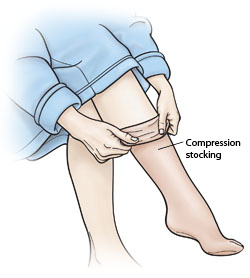Managing Lymphedema After Cancer
Managing Lymphedema After Cancer
Lymphedema is a problem that may occur after cancer surgery when lymph nodes are removed. Or it may occur after radiation to the lymph nodes. Lymphedema can occur months or even many years after cancer treatment. It is an ongoing (chronic) condition that has no cure. But steps can be taken to help reduce or relieve symptoms. If left untreated, lymphedema can get worse. Treatment can lower your risk for infections and complications.
Understanding lymphedema
The lymphatic system helps the body fight infection. It is made up of a system of small vessels all over the body. Lymph fluid travels through these vessels. Many tiny organs called lymph nodes are scattered along the vessels. These nodes filter lymph fluid. During surgery for cancer, nearby lymph nodes are often removed. Sometimes radiation is used to treat lymph nodes as part of cancer treatment. Both of these disrupt the flow of lymph fluid, which can lead to swelling. This is lymphedema. Lymphedema can affect one or both arms or legs, the genitals, the head and neck, or the belly, depending on the part of the body treated. Swelling can get worse and become severe. Skin sores or other problems can develop. Affected areas are also more likely to become infected.
Lymphedema treatment
There are no medicines currently used to treat lymphedema. Instead, the most common treatment for lymphedema is complete decongestive therapy (CDT). This is a set of methods used together to reduce your symptoms. CDT is done by trained therapists. To help show how well the treatment is working, your arms or legs may be measured before and after CDT. The treatment most often involves 1 or more of the following:
Manual lymphatic drainage. This is a kind of massage that uses gentle pressure to help move lymph out of areas where it is collecting. It is done by a therapist or nurse with special training. It can also be learned and done at home.
Intermittent pneumatic compression. This uses a device to apply and relieve pressure to the arms or legs. Sleeves are put over the arms or legs. A pump fills the sleeves with air. Then the air is let out. This happens many times in a row.
Compression bandages. This means wearing stretchy or padded fabric on the parts of the body with lymphedema. This may include bandages, tape, or other types of compression wraps. They help support your tissues so lymph can flow more freely. And they help prevent lymph fluid from building up.
Therapeutic exercises. Some kinds of exercise may help your symptoms. These may include aerobic exercise, such as brisk walking. And they may also include gradual weight-lifting exercises that build muscle.
Skin and nail care. Proper care of your skin and nails will help prevent infection. See the “Preventing Infection for Life” section for more information.
Compression garments. These are worn as often as needed, for life. These include sleeves, gloves, stockings, undershirt, or other types of special clothes. They squeeze or compress parts of the body to help prevent lymph buildup. You may wear these during the day, or at night when you’re asleep.
Tips for living with lymphedema
Don't get too cold or too hot. This can cause the skin to swell and dry out. It can also cause more fluid to build up. Be careful around hot objects to avoid burns. Don’t use hot tubs, saunas, ice packs, or a heating pad.
Don't wear anything that squeezes the affected area. This may cause more swelling. Wear loose clothing and jewelry. If your legs are affected, don’t wear tight socks or undergarments, and don't cross your legs when you sit. This can block lymph drainage.
Don't gain weight. This can make your symptoms worse.
Tell your healthcare providers. If your arms are affected, tell your healthcare providers about your lymphedema before getting shots, an IV, or having your blood pressure taken.
When to call your healthcare provider
Call your healthcare provider right away if you have:
Fever of 100.4ºF (38ºC) or higher, or as directed by your healthcare provider
Signs of infection such as red blotches, warmth, or pain
Sudden increase in swelling
New pain in the affected area
Preventing infection for life
An important part of staying healthy with lymphedema is preventing infections in the swollen areas. Lymphedema makes it easier for germs (bacteria) to grow in those areas. To help prevent infection:
Keep your skin clean, and moisturize it with lotion.
Be extra careful when shaving, and use a clean razor on clean skin.
Check your skin regularly for cuts, sores, bug bites, or other problems.
Use an antibacterial ointment if you have a cut or sore.
Don't pick at, bite, or cut the skin around your fingernails. Use a cuticle stick to push your cuticles back.
Trim your fingernails and toenails straight across to prevent ingrown nails.
If at all possible, don't allow blood to be taken or shots given in any affected limb.
Prevent skin burns by wearing sunscreen and using gloves when cooking or doing household work.
Wear shoes that fit well and don't cause blisters.
Use an insect repellent so you don't get bug bites when outdoors.
Working with your healthcare team
Get regular checkups and report any changes right away. See a specially trained lymphedema therapist to learn more about lymphedema and to get help managing it.
Updated:
February 08, 2018
Sources:
Lymphedema after cancer surgery, Up To Date, Prevention and treatment of lymphedema, Up To Date
Reviewed By:
Gersten, Todd, MD,Stump-Sutliff, Kim, RN, MSN, AOCNS
